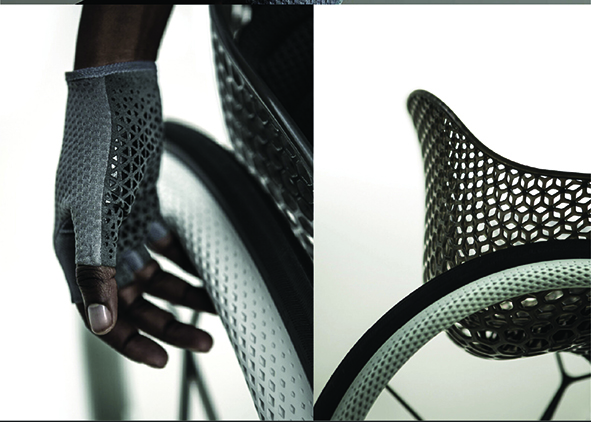Design generativo e prodotto industriale. Connettere la dimensione fisica/digitale del progetto
DOI:
https://doi.org/10.19229/2464-9309/10142021Parole chiave:
design computazionale, morfogenesi, fabbricazione additiva, ricerca della forma, parametricismoAbstract
L’evoluzione delle tecniche di modellazione ha permesso di connettere in maniera sempre più efficiente ciò che è fisico con ciò che è progettato virtualmente, grazie all’utilizzo di processi di simulazione che hanno consentito l’evoluzione delle condizioni d’uso e produzione fisica del modello. Il presente contributo intende discutere, attraverso la proposizione di casi studio emblematici, come l’implementazione delle nuove tecnologie virtuali di modellazione parametrica generativa abbia consentito di evolvere e migliorare, in termini di efficienza e innovazione, lo sviluppo dei prodotti industriali. Il progettista assume quindi un ruolo centrale nella sperimentazione di nuove metodologie progettuali finalizzate all’uso del modello virtuale non più come mezzo di mera espressione formale ma come processo di ottimizzazione sotto molteplici punti di vista.
Downloads
##plugins.generic.articleMetricsGraph.articlePageHeading##
Riferimenti bibliografici
Ajla, A. (2016), Integrating Innovation in Architecture – Design, Methods and Technology for Progressive Practice and Research, John Wiley & Sons, Chichester. [Online] Available at: doi.org/10.1002/9781119164807 [Accessed 23 October 2021].
De Giovanni, G. and Sposito, C. (2019) “Dettagli d’autore – Dal disegno manuale dei grandi Maestri a quello digitale delle Archistar | Master’s details – From hand-made drawing of the great masters to the digital drawing of Starchitects”, in Techne | Journal of Technology for Architecture and Environment, vol. 18, pp. 99-109. [Online] Available at: doi.org/10.13128/techne-7516 [Accessed 15 October 2021].
Gallagher, C. L., Reaser, L., Crane, P., Ataide, R. A., Mauerman, D., Undesser, M., Nunez, D. and Ku-shner, A. (2014), Can 3D printing unlock bioinspiration’s full potential?, Fermanian Business & Economic Institute, San Diego. [Online] Available at: docplayer.net/38411869-Can-3d-printing-unlock-bioinspiration-s-full-potential.html [Accessed 25 October 2021].
Langella, C. and Santulli, C. (2017), “Processi di crescita biologica e Design parametrico”, in MD Journal, vol. 3, n. 1, pp. 14-27. [Online] Available at: mdj.materialdesign.it/index.php/mdj/article/view/85 [Accessed 18 October 2021].
Marsault, X. (2017), Eco-generative Design for Early Stages of Architecture, vol. 1, Wiley-ISTE, London-Hoboken.
Migliore, E., Caruso, I. and Giambattista, A. (2015), “Digital materials – La nuova materialità biologicamente digitale”, in Digicult, 02/09/2015. [Online] Available at: digicult.it/it/news/digital-materials-a-new-biologically-digital-materiality/ [Accessed 25 October 2021].
Oxman, R. (2017), “Thinking difference – Theories and models of parametric design thinking”, in Design Studies, n. 52, pp. 4-39. [Online] Available at: doi.org/10.1016/j.destud.2017.06.001 [Accessed 23 October 2021].
Romero, M. E. (2014), “Physical Computing – Strumento progettuale per i designer di oggi”, in Rossi, M. and Casale, A. (eds), Uno (nessuno) centomila – Prototipi in movimento – Trasformazioni dinamiche del disegno e nuove tecnologie per il design – Workshop marzo-maggio 2014, Maggioli, Santarcangelo di Romagna (RN), pp. 125-136. [Online] Available at: re.public.polimi.it/retrieve/handle/11311/848734/87462/unonessunofull.pdf [Accessed 25 October 2021].
Schumacher, P. (2016), “Parametricism 2.0 – Gearing Up to Impact the Global Built Environment”, in Architectural Design, vol. 86, issue 2, pp. 8-17. [Online] Available at: onlinelibrary.wiley.com/toc/15542769/2016/86/2 [Accessed 25 October 2021].
Schumacher, P. (2009), “Parametricism – A new global style for architecture and urban design”, in AD Architectural Design, vol. 79, issue 4, pp. 14-23. [Online] Available at: doi.org/10.1002/ad.912 [Accessed 26 October 2021].
Sennett, R. (2008), L’uomo artigiano, Feltrinelli, Milano.
Stinson, L. (2017), “John Maeda – If You Want to Survive in Design, You Better Learn to Code”, in Wired, 15/03/2017. [Online] Available at: wired.com/2017/03/john-maeda-want-survive-design-better-learn-code/ [Accessed 20 October 2021].
von Uexküll, J. (2015), Biologia Teoretica, Macerata, Quodlibet.

##submission.downloads##
Pubblicato
Come citare
Fascicolo
Sezione
Licenza
AGATHÓN è pubblicata sotto la licenza Creative Commons Attribution License 4.0 (CC-BY).
License scheme | Legal code
Questa licenza consente a chiunque di:
Condividere: riprodurre, distribuire, comunicare al pubblico, esporre in pubblico, rappresentare, eseguire e recitare questo materiale con qualsiasi mezzo e formato.
Modificare: remixare, trasformare il materiale e basarti su di esso per le tue opere per qualsiasi fine, anche commerciale.
Alle seguenti condizioni
Attribuzione: si deve riconoscere una menzione di paternità adeguata, fornire un link alla licenza e indicare se sono state effettuate delle modifiche; si può fare ciò in qualsiasi maniera ragionevole possibile, ma non con modalità tali da suggerire che il licenziante avalli l'utilizzatore o l'utilizzo del suo materiale.
Divieto di restrizioni aggiuntive: non si possono applicare termini legali o misure tecnologiche che impongano ad altri soggetti dei vincoli giuridici su quanto la licenza consente di fare.
Note
Non si è tenuti a rispettare i termini della licenza per quelle componenti del materiale che siano in pubblico dominio o nei casi in cui il nuovo utilizzo sia consentito da una eccezione o limitazione prevista dalla legge.
Non sono fornite garanzie. La licenza può non conferire tutte le autorizzazioni necessarie per l'utilizzo che ci si prefigge. Ad esempio, diritti di terzi come i diritti all'immagine, alla riservatezza e i diritti morali potrebbero restringere gli usi del materiale.


















































































